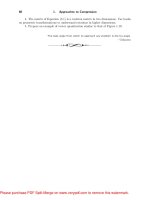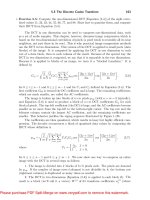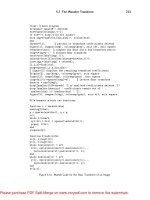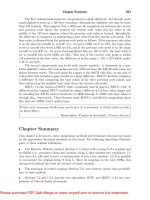A concise introduction to econometrics {repost}
Bạn đang xem bản rút gọn của tài liệu. Xem và tải ngay bản đầy đủ của tài liệu tại đây (1.88 MB, 131 trang )
www.ebook3000.com
This page intentionally left blank
www.ebook3000.com
A Concise Introduction to Econometrics
In this short and very practical introduction to econometrics
Philip Hans Franses guides the reader through the essential
concepts of econometrics. Central to the book are practical
questions in various economic disciplines, which can be answered using econometric methods and models. The book
focuses on a limited number of the essential, most widely
used methods, before going on to review the basics of econometrics. The book ends with a number of case studies drawn
from recent empirical work to provide an intuitive illustration of what econometricians do when faced with practical
questions. Throughout the book Franses emphasizes the importance of specification, evaluation, and implementation of
models appropriate to the data.
Assuming basic familiarity only with matrix algebra and
calculus, the book is designed to appeal as either a short
stand-alone introduction for students embarking on an empirical research project or as a supplement to any standard
introductory textbook.
P H I L I P H A N S F R A N S E S is Professor of Applied Econometrics
and Professor of Marketing Research at Erasmus University,
Rotterdam. He has published articles in leading journals and
serves on a number of editorial boards, and has authored
several textbooks, including Non-Linear Time Series Models in
Empirical Finance (2001, with Dick van Dijk).
www.ebook3000.com
www.ebook3000.com
A Concise Introduction
to Econometrics
An Intuitive Guide
Philip Hans Franses
Econometric Institute,
Erasmus University, Rotterdam
www.ebook3000.com
The Pitt Building, Trumpington Street, Cambridge, United Kingdom
The Edinburgh Building, Cambridge CB2 2RU, UK
40 West 20th Street, New York, NY 10011-4211, USA
477 Williamstown Road, Port Melbourne, VIC 3207, Australia
Ruiz de Alarcón 13, 28014 Madrid, Spain
Dock House, The Waterfront, Cape Town 8001, South Africa
© Philip Hans Franses 2004
First published in printed format 2002
ISBN 0-511-04272-8 eBook (netLibrary)
ISBN 0-521-81769-2 hardback
ISBN 0-521-52090-8 paperback
www.ebook3000.com
Contents
List of figures
page vii
List of tables
viii
Preface
ix
1 Introduction
1
What is econometrics?
Why this book?
Outline of the book
1
7
11
2 A few basic tools
13
Distributions
The linear regression model
Inference
Some further considerations
To summarize
14
19
24
30
33
3 Econometrics, a guided tour
36
Practical questions
Problem formulation
Data collection
Choice of an econometric model
v
www.ebook3000.com
37
39
46
62
Contents
Empirical analysis
Answering practical questions
66
77
4 Seven case studies
81
Convergence between rich and poor countries
Direct mail target selection
Automatic trading
Forecasting sharp increases in unemployment
Modeling brand choice dynamics
Two noneconomic illustrations
5 Conclusion
82
86
89
93
97
101
108
Always take an econometrics course!
Econometrics is practice
108
110
References
111
Index
115
vi
www.ebook3000.com
Figures
2. 1 A probability density function: a normal distribution
page 16
2. 2 A cumulative density function: a normal distribution
18
4. 1 Monthly US total unemployment rate (January
1969–December 1997)
93
4. 2 Percentage of undecided voters (1978–1996),
weekly observations
103
4. 3 Weekly temperatures in The Netherlands (1961–1985)
105
vii
www.ebook3000.com
Tables
4. 1 Clusters of countries for various indicators of
living standards
page 85
4. 2 Estimation results for a model consisting of an
equation for response and one for gift size
88
4. 3 Testing whether transaction costs are different
92
4. 4 Dynamic effects of marketing instruments on brand
choice
101
4. 5 Parameter estimates for a GARCH model for weekly
temperatures
107
viii
www.ebook3000.com
Preface
T
his book is targeted at two distinct audiences. The first
audience concerns novices in econometrics who con-
sider taking an econometrics course in an advanced undergraduate or a graduate program. For them, this book aims to
be an introduction to the field, and hopefully such that they
do indeed take such courses. It should be stressed, though,
that this is not a condescending book – that is, it is not something like “econometrics for dummies.” On the contrary, the
reader is taken seriously and hence some effort is required.
The second audience consists of colleagues who teach these
courses. It is my belief that many econometrics courses, by
zooming in on theory and less on practice, are missing the
most important aspect of econometrics, which is that it truly
is a very practical discipline.
Therefore, central to this book are practical questions in
various economic disciplines such as macroeconomics, finance, and marketing, which might be answered by using
econometric tools. After a brief discussion of a few basic
tools, I review various aspects of econometric modeling.
ix
Preface
Along these lines, I also discuss matters which are typically
skipped in currently available textbooks, but which are very
relevant when one aims to apply econometric methods in
practice. Next, several case studies should provide some intuition of what econometricians do when they face practical
questions. Important concepts are shown in italic type; examples of practical questions which econometricians aim to
answer will be shown in bold type.
This book might be used prior to any textbook on econometrics. It can, however, never replace one of these, as the
discussion in this book is deliberately very sketchy. Also, at
times this book has a somewhat polemic style, and this is
done on purpose. In fact, this is the “personal twist” in this
book. Therefore, the book should not be seen as the ultimate treatment of the topic, but merely as a (hopefully)
joyful read before one takes or gives econometrics classes.
Hence, the book can be viewed as a very lengthy introductory chapter.
Finally, as a way of examining whether a reader has appreciated the content of this book, one might think about
the following exercise. Take a newspaper or a news magazine and look for articles on economic issues. In many articles are reports on decisions which have been made, forecasts that have been generated, and questions that have
been answered. Take one of these articles, and then ask
whether these decisions, forecasts, and answers could have
been based on the outcomes of an econometric model. What
kind of data could one have used? What could the model
x
Preface
have looked like? Would one have great confidence in these
outcomes, and how does this extend to the reported decisions, forecasts, and answers?
I wish to thank Clive Granger and Ashwin Rattan at
Cambridge University Press, for encouragement and helpful
comments. Also, many thanks are due to Martijn de Jong,
Dick van Dijk, and in particular Christiaan Heij for their
very constructive remarks. Further comments or suggestions are always welcome. The address for correspondence is
Econometric Institute, Erasmus University Rotterdam, P.O.
B ox 1738, NL-3000 DR Rotterdam, The Netherlands, email:
PHILIP HANS FRANSES
Rotterdam
xi
CHAPTER ONE
Introduction
I
n this chapter I provide an introductory discussion of
what econometrics is and what econometricians do. Next,
I consider a more detailed motivation for writing this book.
Finally, I give an outline of the other chapters of the
book.
What is econometrics?
Econometric techniques are usually developed and employed for answering practical questions. As the first five
letters of the word “econometrics” indicate, these questions
tend to deal with economic issues, although applications to
other disciplines are widespread. The economic issues can
concern macroeconomics, international economics, and microeconomics, but also finance, marketing, and accounting.
The questions usually aim at a better understanding of an
actually observed phenomenon and sometimes also at providing forecasts for future situations. Often it is hoped that
these insights can be used to modify current policies or to
1
A Concise Introduction to Econometrics
put forward new strategies. For example, one may wonder
about the causes of economic crises, and if these are identified, one can think of trying to reduce the effects of crises in
the future. Or, it may be interesting to know what motivates
people to donate to charity, and use this in order to better
address prospective donors. One can also try to understand
how stock markets go up – and, particularly, how they go
down – in order to adjust investment decisions.
The whole range of econometric methods is usually simply called “econometrics,” and this will also be done in this
book. And anyone who either invents new econometric
techniques, or applies old or new techniques, is called an
“econometrician.” One might also think of an econometrician as being a statistician who investigates the properties
particular to economic data. Econometrics can be divided
into econometric theory and applied econometrics. Econometric
theory usually involves the development of new methods
and the study of their properties. Applied econometrics concerns the development and application of tools to solve
relevant practical questions.
In order to answer practical questions, econometric techniques are applied to actually observed data. These data can
concern (1) observations over time, like a country’s GDP
when measured annually, (2) observations across individuals, like donations to charity, or (3) observations over time
and over individuals. Perhaps “individuals” would be better
phrased as “individual cases,” to indicate that these observations can also concern countries, firms, or households, to
2
Introduction
mention just a few. Additionally, when one thinks about
observations over time, these can concern seconds, days, or
years.
Sometimes the relevant data are easy to access. Financial
data concerning, for example, stock markets, can be found in
daily newspapers or on the internet. Macroeconomic data on
imports, exports, consumption, and income are often available on a monthly basis. In both cases one may need to pay
a statistical agency in order to be able to download macroeconomic and financial indicators. Data in marketing are less
easy to obtain, and this can be owing to issues of confidentiality. In general, data on individual behavior are not easy
and usually are costly to obtain, and often one has to survey
individuals oneself.
As one might expect, the type of question that one intends
to answer using an econometric method is closely linked to
the availability of actual data. When one can obtain purchase behavior of various households, one can try to answer
questions about this behavior. If there are almost no data,
there is usually not much to say. For example, a question
like “how many households will use this new product within 10 years from now?” seems rather difficult to
answer. And, “what would the stock market do next
year?” is complicated, too. Of course, one can always come
up with an answer, but whether one would have great confidence in this answer is rather doubtful. This touches upon
a key aspect of the application of econometric techniques,
which is that one aims at answering questions with some
3
A Concise Introduction to Econometrics
degree of confidence. In other words, econometricians do not
provide answers like “yes” or “no,” but instead one will hear
something like “with great confidence we believe that poor
countries will not catch up with rich countries within the
next 25 years.” Usually, the size of “great” in “great confidence” is a choice, although a typical phrase would be something like “with 95 per cent confidence.” What that means
will become clear in chapter 2 below.
The econometrician uses an econometric model. This model
usually amounts to one or more equations. In words, these
equations can be like “the probability that an individual donates to charity is 0.6 when the same individual donated last
time and 0.2 when s/he did not,” or “on average, today’s
stock market return on the Amsterdam Exchange is equal
to yesterday’s return on the New York Stock Exchange,” or
“the upward trend in Nigeria’s per capita GDP is half the size
of that of Kenya.” Even though these three examples are
hypothetical, the verbal expressions come close to the outcomes of actual econometric models.
The key activities of econometricians can now be illustrated. First, an econometrician needs to translate a practical question like, for example, “what can explain today’s
stock market returns in Amsterdam?” into a model. This
usually amounts to thinking about the economic issue at
stake, and also about the availability and quality of the data.
Fluctuations in the Dow Jones may lead to similar fluctuations in Amsterdam, and this is perhaps not much of a
surprise. However, it is by no means certain that this is best
4
Introduction
observed for daily data. Indeed, perhaps one should focus
only on the first few minutes of a trading day, or perhaps
even look at monthly data to get rid of erratic and irrelevant fluctuations, thereby obtaining a better overall picture.
In sum, a key activity is to translate a practical question
into an econometric model, where this model also somehow matches with the available data. For this translation,
econometricians tend to rely on mathematics, as a sort of
language. Econometricians are by no means mathematicians, but mathematical tools usually serve to condense notation and simplify certain technical matters. First, it comes
in handy to know a little bit about matrix algebra before taking econometrics courses. Note that in this book I will not
use any such algebra as I will just stick to simple examples.
Second, it is relevant to know some of the basics of calculus,
in particular, differential and integral calculus. To become
an econometrician, one needs to have some knowledge of
these tools.
The second key activity of an econometrician concerns
the match of the model with the data. In the examples above,
one could note numerical statements such as “equal” or
“half the size.” How does one get these numbers? There
are various methods to get them, and these are collected
under the header “estimation.” More precisely, these numbers are often associated with unknown parameters. The
notion “parameter estimation” already indicates that econometricians are never certain about these numbers. However,
what econometricians can do is to provide a certain degree of
5
A Concise Introduction to Econometrics
confidence around these numbers. For example, one could
say that “it is very likely that growth in per capita GDP
in Nigeria is smaller than that of Kenya” or that “it is
unlikely that an individual donates to charity again if
s/he did last time.” To make such statements, econometricians use statistical techniques.
Finally, a third key activity concerns the implementation
of the model outcomes. This may mean the construction of
forecasts. It can also be possible to simulate the properties
of the model and thereby examine the effects of various
policy rules.
To summarize, econometricians use economic insights
and mathematical language to construct their econometric model, and they use statistical techniques to analyze its
properties. This combination of three input disciplines ensures that courses in econometrics are not the easiest ones
to study.
In this book I try to introduce the essentials of econometrics to novices, keeping the mathematical and statistical level
at a minimum, but without being condescending. This book
can be used prior to any textbook on econometrics, but it
should certainly not replace it! The intention is that this book
should be used as introductory and supplementary reading. For textbooks on econometrics, one can choose from
Verbeek (2000), Koop (2000), Gujarati (1999), Kennedy
(1998), Ramanathan (1997), Johnston and Dinardo (1996),
Griffiths, Hill and Judge (1993), and Goldberger (1991) at
the introductory level, from Heij et al. (2002), Ruud (2000),
6
www.ebook3000.com
Introduction
Greene (1999), Wooldridge (1999), and Poirier (1995), at
the intermediate level, and from White (2000), Davidson
and MacKinnon (1993), and Amemiya (1985), at the advanced level. For more specific analysis of time series, one
can consider Franses (1998), Hamilton (1994), and Hendry
(1995), and for financial econometrics, see Campbell, Lo and
MacKinlay (1997).
So, do you have any interest in reading more about econometrics? If you are really a novice, then you can perhaps
better skip the next section as this is mainly written for colleagues and more experienced econometricians. The final
section is helpful, though, as it provides an outline of subsequent chapters.
Why this book?
Fellow econometricians may now wonder why I decided
to write this book in the first place. Well, the motivation
was based on my teaching experience at the Econometric
Institute of the Erasmus University Rotterdam, where we
teach econometrics at undergraduate level. My experience
mainly concerns the empirical projects that undergraduate
students have to do in their final year before graduation.
For these projects, many students work as an intern, for
example, with a bank or a consultancy firm, and they are
supposed to answer a practical question which the supervising manager may have. Typically, this manager knows
that econometricians can handle empirical data, and usually
7
A Concise Introduction to Econometrics
they claim to have available abundant data. Once the student starts working on the project, the following scenario is
quite common. The manager appears not to have an exact
question in mind, and the student ends up not only constructing an econometric model, but also precisely formulating the question. It is this combination that students find
difficult, and indeed, a typical question I get is “how do I
start?”
Observing this phenomenon, I became aware that many
econometric textbooks behave as if the model is already
given from the outset, and it seems to be suggested that
the only thing an econometrician needs to do is to estimate the unknown parameters. Of course, there are many
different models for different types of data, but this usually implies that textbooks contain a range of chapters
treating parameter estimation in different models (see also
Granger, 1994). Note that more recent textbooks also address the possibility that the model may be inappropriate and
therefore these books contain discussions about diagnostic
checks.
Of course, to address in a single textbook all the practical steps that one can take seems like an impossible enterprise. However, it should be possible to indicate various
issues other than parameter estimation that arise when one
wants to arrive at a useful econometric model. Therefore, in
chapter 3 I will go through various concerns that econometricians have when they aim to answer a practical question.
This is not to say that parameter estimation is unimportant.
8
Introduction
I merely aim to convey that in practice there is usually no
model to begin with!
Without wishing to go into philosophical discussions
about econometrics, it seems fair to state that the notion
of “a model given from the outset” dates back to the first
developments in econometrics. In the old days (like, say,
fifty years ago), econometricians were supposed to match
(mainly macro-) economic theories to data, often with an
explicit goal to substantiate the theory. In the unlucky event
that the econometric model failed to provide evidence in
favor of the theory, it was usually perceived that perhaps
the data were wrong or the estimation method was incorrect, implying that the econometrician could start all over
again.
A format of a typical econometrics textbook has its origin
in this traditional view of econometrics. This view assumes
that most aspects of a model, like the relevant variables,
the way they are measured, the data themselves, and the
functional form, are already available to the econometrician, and the only thing s/he needs to do is to fit the model
to the data. The model components are usually assumed
to originate from an (often macro-) economic theory, and
there is great confidence in its validity. A consequence of this
confidence is that if the data cannot be summarized by this
model, the econometric textbook first advises us to consider
alternative estimation techniques. Finally, and conditional
upon a successful result, the resultant empirical econometric model is used to confirm (and perhaps in some cases,
9
A Concise Introduction to Econometrics
to disconfirm) the thoughts summarized in the economic
theory. See Morgan (1990, 2002) for a detailed analysis of
the development of econometric ideas.
There are several reasons why this traditional view is losing territory. The first is that there is a decreasing confidence
in the usefulness of econometric models to confirm or disconfirm economic theories. Summers (1991) convincingly
argues that important new macroeconomic insights can also
be obtained from applying rather simple statistical techniques, and that the benefit of considering more complicated
models is small. Granger (1999) gives a lucid illustration of
the fact that the implications of even a simple economic theory are hard to verify.
With an increased application of econometric methods
in finance and marketing, there also seems to be a need
for teaching econometrics differently. The main reason for
this need is that it is usually impossible to have strong
prior thoughts about the model. Also, these modern application areas require new models, which are suggested
by the data more than by a theory – see Engle (1995),
Wansbeek and Wedel (1999), for example. Hence, an econometrician nowadays uses the data and other sources of information to construct the econometric model. With this
stronger emphasis on the data, it becomes important to address in more detail the specification of a model, the evaluation of a model, and its implementation. The evaluation
part is relevant for obtaining confidence in the outcomes. It
10
Introduction
is of course impossible to treat all these issues, and hence
my decision to give a “guided tour.”
Outline of the book
The remainder of this book consists of four chapters, of
which the last merely presents a few recommendations.
Chapter 2 deals with a brief discussion of a few basic tools,
and in fact it can be viewed as a very short overview of
what a typical textbook in econometrics in part aims to tell.
Most of the material in this chapter should be interpreted as
discussing language and concepts.
As is common, I start with the linear regression model,
which is the basic workhorse of an econometrician. Next,
I discuss various matters of interest within the context of
this model. I will try to explain these in plain English, at
least if that is possible. To highlight important concepts, I
will put them in italic type. Examples of practical questions
which econometricians aim to answer will be highlighted in
bold type.
Chapter 3 outlines most of the issues relevant for constructing an econometric model to answer a practical question. In this chapter I will try to indicate that parameter
estimation, once the model is given and the data are available, amounts to only a relatively small fragment of the
whole process. In fact, the process of translating a question into a model involves many important decisions, which
11









